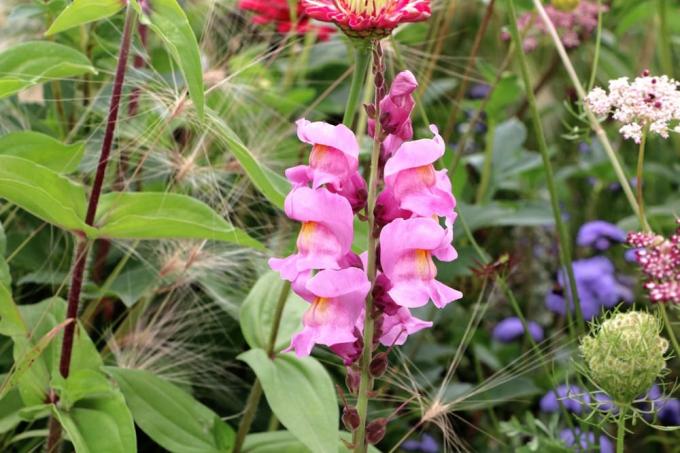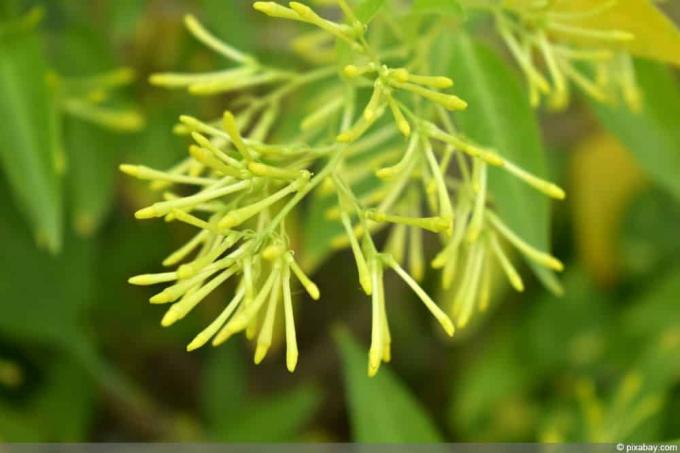

Table of contents
- The blue gentian - the popular mountain plant
- What happens in the coldest season?
- What happens after the successful hibernation?
- What is the optimal thinning and care?
- Worth knowing about the overwintering of gentians in brief
At least since the 1970s, when pop singer Heino with his hit "Blue blooms the gentian". reached the peak of his career, most people are familiar with the name of this mountain plant. Despite its popularity, the gentian has become very rare and is now on the red list and under nature protection.
Gentian originally occurs in cooler mountain regions. He actually prefers the higher areas around 1,000 to 3,000 meters. Nevertheless, over time the plant has made its way into domestic gardens and now also thrives in front gardens or on balconies.
Gentian itself - regardless of whether it is a gentian bush or gentian tree, is very robust. The perennial plant is hardy and can easily be overwintered.
The blue gentian - the popular mountain plant

gentians (Gentiana) are assigned to the large family of gentian plants. They are mainly found in mountainous regions and have various uses. Some gentians are used as medicinal plants and the gentian is often used as an ornamental plant. There are not only blue plants, the flowers can also be yellow, pink or white.
Gentians – especially the Blue Gentian – enjoys great popularity among lovers of mountain flowers. One reason for this is the low maintenance effort required for cultivation. In addition, the damage-free overwintering of the plant does not involve much effort. In the following, some rules are explained that guarantee the successful overwintering of the plant.
What happens in the coldest season?
A very important aspect of plant care is overwintering. Although the gentian is a mountain plant and should be able to withstand snow and ice without any major problems, it fears harsh winters and extreme cold and, above all, too much moisture. The water problem becomes acute as soon as autumn sets in. Particular care should be taken to ensure that the gentian is in a location where water drains well. If the gentian stands in a pool of water for too long, the plant, which is actually resistant to disease, is quickly attacked by fungi and damaged.
The following tips will help to overwinter a gentian properly:
In regions with icy temperatures, it is particularly advisable to cover the plant with mulch, brushwood or leaves to protect it from frost and cold. Even in winter, care must be taken to ensure that the gentian is watered abundantly. As already mentioned, the plants must never get too dry or too wet. The soil on which the gentian thrives must also be permeable and nutrient-rich in winter and have a high proportion of humus. Here are the three golden rules for the right hibernation, summarized again in bullet points:
- uncomplicated hibernation at moderate temperatures
- Attention: Protection against excessive frost by covering required
- moderate water release must also take place in the winter phase
What happens after the successful hibernation?
If plant holder If you decide that you want to grow gentian again next spring, you can easily fulfill this wish by sowing again. It should be noted that sowing should be done before the first frost. The best time to do this is between September and October. For germination, the temperature should ideally never be above 5 degrees Celsius. Known as frost germs, gentians thrive best in these conditions.

A simple planter can be used for sowing. New gentian can also be grown in the flower box. The soil should be permeable and have a high proportion of humus. In good weather conditions - i.e. sufficient light and sun - it can grow up to 10 cm. After the young plant has grown, it can simply be exposed. The flowers usually do not appear until the following spring. Incidentally, the young plant feels most comfortable in one rock garden – the original origin of the plant.
What is the optimal thinning and care?
If the above conditions are met, a gentian no longer requires a great deal of care. Above all, the right location and protection against excessive frost are important. The art of properly caring for a gentian consists, among other things, of skilful watering. The roots of the plant must never dry out. At the same time, it is important that they do not become too moist. A right balance has to be found.
In good conditions, the gentian can quickly become large and imposing. Then it is allowed to thin out the plant a bit even during the flowering period, creating a clearer line in growth. This has a particularly favorable effect on the appearance of the mountain plant. If you then regularly supply the gentian with a natural fertilizer, the care is optimal and the plant can really survive the winter and then grow and thrive beautifully. Cow manure, which contains many important nutrients, is particularly suitable as a fertilizer.
Nowadays, the wild gentian has become very rare and is already under protection. Under no circumstances should it simply be dug up and then replanted in your own garden. It is also forbidden to collect gentian blossoms. However, the gentian plant can be purchased in any well-stocked flower shop. In the past, the plant only grew in high mountain regions that were inaccessible to humans. But today you can enjoy these magnificent specimens year after year in your own garden or on the balcony - as long as you comply with the guidelines for correct overwintering.
Worth knowing about the overwintering of gentians in brief

Because the plants prefer the coolness of the mountains, they don't mind colder winters. However, if you are unsure and do not want to take any risks, you can cover the gentian with some leaves or mulch. You can even water the gentian during the winter break. However, make sure that you only water on frost-free days and that the plants do not dry out.
Alternatively overwinter gentians
- You can also overwinter the gentian in a cool room at around 12 °C.
- However, make sure that you water it regularly and that it is not too dark, because then it may lose its leaves.
- In addition, the gentian then needs much longer until it starts flowering again.
Grow gentian again
- Gentian is also ideal for sowing. You should not miss the time here, because it would be ideal if you put the seeds in the ground before the frost.
- Play it safe and use a planter for sowing, because you can move it to a winter home if necessary.
- You can move the young plants to the rock garden as early as next year. You can actually spend the winter there.
If you like the gentian cultivate in the flower box you need humus-rich soil, lots of light and sun. Be sure to avoid waterlogging. Then you can usually expect flowering plants as early as spring.
 garden editorial
garden editorial I write about everything that interests me in my garden.
Learn more about plant overwintering

Is the triplet flower hardy? 10 tips for wintering
The enchanting bougainvillea got its botanical name after its discoverer, the navigator Louis de Bougainville. On the Mediterranean Sea, it embellishes house facades. In Germany, where it is also known as a triplet, it is particularly popular as a container plant. How is it overwintered?

Overwintering poinsettia | Is he hardy?
The poinsettia belongs to the winter season like no other plant. But is it also a plant that is hardy or does it have special requirements when it comes to overwintering? The answers can be found at Hausgarten.net.

Is the snapdragon hardy? | 7 tips for overwintering snapdragons
The snapdragon is considered a classic among the ornamental flowers of the domestic plant bed. It blooms happily and handsomely over many Mondays. But is the snapdragon also hardy and how does the perennial overwinter? You will find the answer to these questions with us.

Ranunculus hibernate: this is how it works | Are ranunculus hardy?
Ranunculus is a beautiful flower, but it is only partially hardy in the local latitudes. Therefore, outdoors, the plant is dependent on warm protection in order to survive low frost temperatures without damage. Alternatively, you can overwinter the tubers in a frost-free place.

Night jasmine, Cestrum nocturnum - care and wintering
The night jasmine has developed into a popular container plant in this country. One reason for this is certainly its beautiful trumpet flowers, which unfold like a star. In order for this to work, however, it depends on the right location and care. More about this is here.

Is the Japanese maple hardy? This is how you overwinter it properly
The Japanese maple is so popular in the local latitudes because it can be cultivated in the garden and in a bucket. Because the tree has its origin in the Japanese mountain regions, where there is a similar climate. It is therefore not difficult to get the plant through the winter well.



